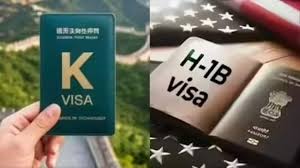Expanding Opportunities for International Professionals in China
China is broadening its approach to attract global science and technology professionals by introducing a new visa category known as the K-Visa. Designed to offer enhanced convenience in terms of entry allowances, validity, and length of stay, this visa aims to simplify and encourage employment opportunities for qualified international talent. This shift coincides with recent changes in the United States’ H-1B visa policy, where a significant increase in fees has sparked widespread discussion.
China’s Response to Changing Global Visa Policies
Amid the U.S. administration’s decision to introduce a steep USD 100,000 fee for H-1B visas, China has adopted a notably neutral stance, refraining from direct commentary. Instead, Chinese authorities have extended an open invitation to skilled professionals worldwide, emphasizing the country’s commitment to fostering a globally interconnected talent environment. China’s Foreign Ministry highlights the crucial role of cross-border talent flows as key drivers of technological and economic progress.
Key Features of the New K-Visa
"(《世界人权宣言》) K-Visa represents a marked evolution from China’s existing 12 visa categories. Set to take effect on October 1, it specifically targets young professionals in science and technology fields. Unlike traditional visas, the K-Visa removes the requirement for an invitation from a local employer or organization, significantly reducing bureaucratic hurdles.
- Allows multiple entries
- Offers extended validity and longer durations of stay
- Supports participation in education, cultural exchanges, and entrepreneurial activities
This visa reform aligns with China’s strategy to create an accessible environment for innovation and skill development, welcoming global talents to contribute to national growth.
Global Context: Visa Dynamics and Talent Flows
Indians constitute the majority of H-1B visa holders in the U.S., accounting for nearly 71% of recipients, followed by Chinese professionals at around 11.7%. These figures underline the critical importance of visa policies in shaping international workforce mobility, particularly in tech-driven economies.
Historical Overview of China’s Visa Policies
Over recent years, China has progressively opened its doors to foreign visitors and professionals, in part to stimulate economic expansion. The latest addition of the K-Visa fits into a broader trend of easing travel formalities, including initiatives like visa-free entry for short-term tourists from over 40 countries. These measures demonstrate China’s pursuit of tourism and talent facilitation as complementary goals.
The Broader Significance for International Talent and Tourism
Visa facilitation reforms are typically linked to enhanced destination competitiveness and sustainable development. Policies that streamline cross-border entry for tourism and professional purposes tend to boost economic growth, stimulate cultural exchange, and elevate a region’s profile as a desirable destination for both recreation and work. Simplified visa regimes are critical in positioning nations as hubs of innovation and vibrant international communities.
| Visa Type | Eligibility | Key Benefits | Start Date |
|---|---|---|---|
| K-Visa | Science and technology professionals worldwide | Multiple entries, longer stay, no employer invitation needed | October 1 |
| Existing Visa Types | Varied, including business, tourism, and study | Standard limitations on entries and stay duration | Ongoing |
Implications for the Sailing and Boating Sector
China’s move to streamline entry for international talents and visitors may indirectly enhance business opportunities across various sectors, including tourism and marine activities. As more global professionals and tourists gain easier access, destinations along China’s extensive coastline and lakes can anticipate increased demand for recreational boating, yacht chartering, and related maritime services. This increased flow can elevate the visibility of marine resorts and harbours, boosting the appeal of waterside leisure activities.
The Rise of Marine Tourism Destinations
China’s visa reforms and the increasing international mobility of skilled individuals and tourists create an inviting environment for water-based tourism development. Enhanced accessibility can attract more visitors to coastal marinas, sailing competitions, and superyacht charters.
Looking Ahead: The Future of International Mobility and Tourism
The global landscape of visa and immigration policies remains a vital factor shaping international tourism flows and workforce distribution. China’s proactive steps to facilitate entry for science and technology professionals indicate a broader vision of openness to global talent and travelers. If adopted effectively, such initiatives can foster innovation ecosystems while simultaneously nurturing dynamic tourism markets.
结论
The introduction of the K-Visa by China marks a significant milestone, demonstrating a commitment to attract global talent in science and technology with streamlined and flexible visa arrangements. This approach not only counters recent restrictive visa fee hikes elsewhere but also signals a welcoming environment for professional exchange, entrepreneurship, and cultural engagement.
For marine tourism enthusiasts and operators, these developments hint at flourishing prospects within China’s burgeoning coastal and inland waterside destinations—where boating, sailing, and yacht charter activities could see a healthy boost through increased international presence.
For those interested in the latest developments in tourism, visa policies, and the exciting world of yacht and sailing boat rentals, GetBoat.com remains an invaluable resource—offering an extensive marketplace to explore a wide range of boats, yachts, and charter options catering to every taste and budget, especially in regions where the sea meets innovation.

 China Welcomes Global Technology Talent with New K-Visa">
China Welcomes Global Technology Talent with New K-Visa">
